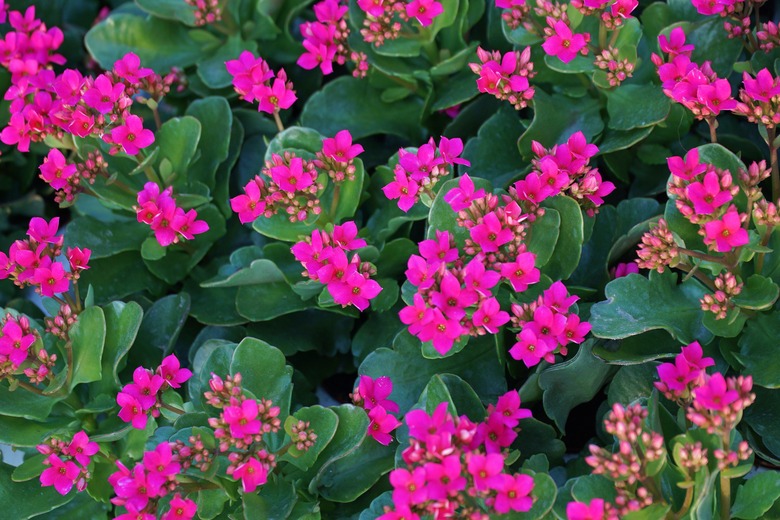Kalanchoe Leaf Problems
We may receive a commission on purchases made from links.
Kalanchoe (Kalanchoe spp., USDA plant hardiness zones 10b to 12a) is a genus of succulent, tropical plants that are commonly grown as houseplants but will thrive outdoors in frost-free regions. Depending on the species (of which there are more than 125), they go by a host of common names, from just kalanchoe to devil's backbone, mother of thousands, and chandelier plant. One of the most popular kalanchoe houseplants is Kalanchoe blossfeldiana, hardy in USDA zones 10 to 12. Although they are typically low-maintenance plants, several conditions can create leaf problems.
Sap Suckers Causing Kalanchoe Problems
Sap Suckers Causing Kalanchoe Problems
Several sap-sucking insects can cause problems with kalanchoe foliage. Quick identification and treatment can keep the leaves looking their best.
Mealybugs are small white pests covered in a cottonlike substance. They cover the leaves and leafstalks as well as sometimes infecting the roots and secreting honeydew, causing black sooty mold on the foliage. The pest causes the kalanchoe to experience stunted growth, leaf wilting, and yellowing. A large infestation of mealybugs can be difficult to control, and disposing of the kalanchoe may be best. You can also treat the pest using insecticidal soap, horticultural oil, or by dabbing the pests with a cotton swab saturated in alcohol, always following label directions.
Scale insects are another sap-sucking pest that can infect kalanchoe plants. They are gray or brown, have a protective covering, and usually remain in one place on the plant. They are typically located on the leaf folds, behind the leaf bases or inside, or inside the blooms. The scales secrete honeydew, making the foliage have a shiny appearance and sticky feel at first. As the pest progresses in its attack, the kalanchoe becomes stunted and its foliage, discolored. You can control scales by carefully scraping them off the affected parts and then treating them with insecticidal soap or horticultural oil that's safe for use on kalanchoes.
Mites, especially spider mites, are another sap-sucking pest infecting kalanchoe plants. Mites are very small. They congregate on the underside of the foliage and can sometimes create a white webbing. The pest causes light leaf spotting and leaf drop with brittle, dry foliage that cups downward, with low indoor humidity and dusty conditions encouraging the pests' development. Severely infected plant disposal is best; however, you can help control the problem by frequently washing the foliage with water, keeping dust at a minimum, trimming off infected portions with clean pruning tools, and if necessary, treating the kalanchoe with horticultural oil or an insecticidal soap safe for use on the plant.
Disease Problems Affecting Kalanchoe Foliage
Disease Problems Affecting Kalanchoe Foliage
Several diseases cause problems with kalanchoe foliage, including powdery mildew, root rot, and systemic bacterial diseases.
A common kalanchoe fungus affecting the plant's foliage is powdery mildew, which shows up as a white or gray powdery substance covering the leaves, stems, and flowers. Although the fungus won't kill the kalanchoe, it can diminish its appearance and cause the foliage to drop. You can easily control the fungus by watering early in the day so the foliage dries, by lowering the humidity, by moving the kalanchoe to brighter conditions, and by moving it away from cold drafts.
Root rot is another problem affecting kalanchoes. It's caused by Phytophthora and Pythium species. Overwatering and poor soil drainage create the problem, with the kalanchoe suffering stunted growth, yellowing foliage and plant parts, and wilting. It also kills part of the root system, turning it blackish-brown. You can prevent the problem by watering weekly early in the day from the bottom of the plant and using a container with drainage holes and well-drained soil.
There are a variety of systemic bacterial diseases that infect the kalanchoe's vascular system and spread throughout the entire plant. When infected, these problems show up through stem rots, cankers, leaf wilting, and yellowing along with root rots and blights. The rots and cankers become mushy and can have an unpleasant odor. Warm, damp conditions encourage the problems, which can be prevented by not overfertilizing or overwatering. Once infected, the best course of action is to discard the kalanchoe.
